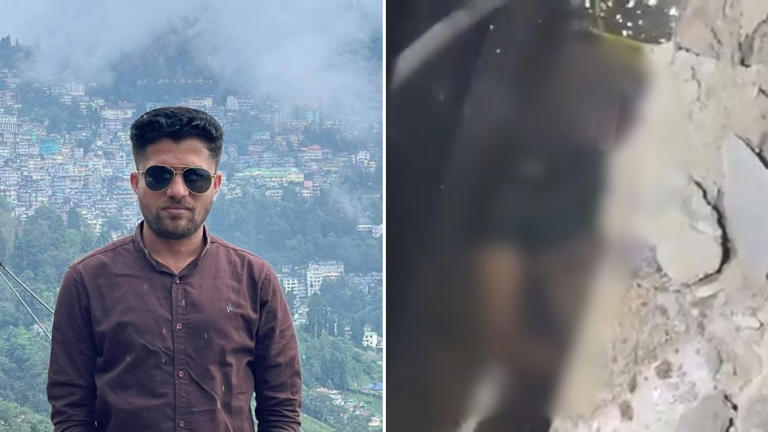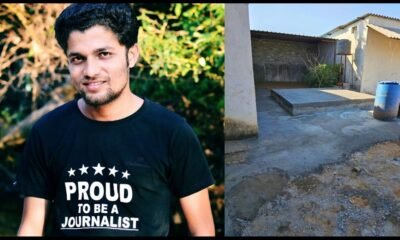In India, justice is swift and thorough—but only if you’re famous, powerful, or well-connected. Take the case of Bollywood actor Saif Ali Khan. When he was allegedly assaulted by a supposed Bangladeshi robber, 20 police teams were deployed to crack the case within hours. But when Mukesh Chandrakar, a journalist fighting corruption in Chhattisgarh, was brutally murdered, the system turned a blind eye.
A Journalist’s Horrific End
28 year old Mukesh wasn’t just a journalist; he was a whistleblower. His work exposed a road construction scam that funneled public money into private pockets. It made him enemies—powerful ones. On January 1, 2025, Mukesh went missing. His family begged the police to investigate. Nothing happened.
Mukesh Chandrakar’s body was found last week in a septic tank in a compound owned by a contractor he had implicated in a story about corruption in Chhattisgarh state. There, Mukesh’s body was found. His neck was broken. His heart had been ripped out. Tortured, murdered, discarded like garbage.
Days later, Mukesh’s brother, desperate for answers states, not the police, but a fellow journalist uncovered the phone’s location. “The police didn’t even try,” Mukesh’s brother said. “They didn’t want to.”
The Sharp Reality
Now, contrast this with Saif Ali Khan’s case. Within hours of the alleged assault, the police mobilized 20 teams to hunt down the perpetrator. Why? Because Saif is a Bollywood star. Because his case was headline-worthy. Mukesh? He was just another ordinary man—a journalist, yes, but not a celebrity. His life, it seems, didn’t warrant the same urgency.
This isn’t just about Mukesh. It’s about a pattern.

A Grim Reality for Indian Journalists
Raunak Shivhare, an independent journalist and a close friend of Mukesh Chandrakar, shared his harrowing perspective with DW, stating that the journalist’s death only garnered nationwide attention due to its unspeakable brutality.
“Journalists in Bastar have been enduring these threats incessantly,” Shivhare said grimly. “We operate here without any semblance of security, knowing that the system will not protect us.”
India’s Steady Decline in Press Freedom
Over the past 15 years, India has witnessed a precipitous fall in its global Press Freedom Index ranking, maintained by Reporters Without Borders (RSF). From a rank of 105 in 2009, India plummeted to 159 in 2024, now trailing behind its neighbor and rival, Pakistan.
“We are witnessing an authoritarian drift, with a clear intention to muzzle independent media and silence critical voices,” warned Celia Mercier, head of RSF’s South Asia Desk. She described the repression as nothing short of “chilling.”
The extent of this repression is etched in blood, with journalists like Mukesh Chandrakar (2025), Gauri Lankesh (2017), and Shashikant Warishe (2023) paying the ultimate price. Lankesh, a fierce critic of right-wing extremism and editor of a Bangalore-based publication, was gunned down in front of her home. Warishe was killed in Maharashtra’s Ratnagiri district, deliberately run over by an SUV driven by a land broker he had exposed in his reporting. In both cases, justice remains elusive.
Official Denials Amid Mounting Evidence
Prime Minister Narendra Modi’s government has consistently dismissed criticisms about India’s deteriorating press freedom. Last year, Information and Broadcasting Minister Ashwini Vaishnaw claimed that global assessments relied on “very low sample sizes and little understanding of India’s vibrant democracy.”
In a parliamentary address, Vaishnaw assured lawmakers of the government’s commitment to free speech, lauding India’s press as “robust and flourishing.” Yet, the lived experiences of journalists outside major urban centers paint a starkly different picture. These reporters, covering corruption, land disputes, and human rights violations, find themselves isolated and unprotected, often targeted by local power brokers and politicians.
Fear and Intimidation
RSF’s Mercier outlined the myriad ways journalists face reprisals: physical attacks, tax raids, frivolous lawsuits, and even imprisonment under draconian anti-terror laws like the Unlawful Activities (Prevention) Act (UAPA).
Cyberharassment has become another insidious tool of suppression. Journalists are routinely branded “anti-nationals” or “traitors” on social media, undermining their credibility and endangering their lives. The assassination of Gauri Lankesh was met with celebratory tweets from accounts followed by none other than Prime Minister Modi himself—a chilling attestation to the environment of hostility journalists endure.
Laws in Limbo
Ruben Banerjee, the general secretary of the Editors Guild of India, pointed out the grim reality of increasing intolerance in the country, which he said directly correlates with the rapid erosion of press freedom.
“Laws have been weaponized and are being used to silence and punish anyone who dares to dissent from the official narrative,” remarked the veteran editor.
In Chhattisgarh, where Mukesh Chandrakar was brutally murdered, an attempt was made to introduce legislation aimed at protecting journalists. However, the initiative has been left to wither, stalled by an evident lack of political will. On a broader scale, the Indian government’s Whistleblower Protection Act remains mired in delays, rendering it ineffective.
India’s overburdened judicial system further compounds the issue. Justice, when it comes, is agonizingly slow. Accused individuals frequently secure bail due to prolonged legal proceedings. The murder of Gauri Lankesh is a chilling example—eight years after her assassination, 17 of the 18 accused are out on bail, while one remains at large.
The Ultimate Form of Censorship
“Mukesh’s death is the penultimate step before the final nail in the coffin of press freedom,” lamented his friend and fellow journalist Raunak Shivhare. “We are terrified. We live with our families in Bastar, and we have no protection. Under such circumstances, continuing to report on sensitive issues feels like walking on a razor’s edge.”
The Committee to Protect Journalists (CPJ) paints an equally grim picture. Since 1992, 60 Indian journalists have lost their lives, the majority being local reporters in small towns—the unsung heroes of grassroots journalism.
“Without swift prosecution, these attacks send a chilling message that such killings are being tolerated,” warned Beh Lih Yi, CPJ’s head of Asia.

Questions That Demand Answers
1) Where is justice for the common man and the fourth pillar of democracy? Journalists like Mukesh risk their lives to uncover the truth. But when they’re attacked, who stands for them?
2) Why do police leap into action for the rich and famous but drag their feet for ordinary citizens? Is justice in this country only for those with money or influence?
3) Why didn’t the police act when Mukesh’s family reported his disappearance? Tracing a phone’s last location is basic investigative work. Why was it ignored?
4) Do common people get justice only when protests erupt? Remember the RG hospital rape and murder case? It took public outrage—mass protests—to push the system into action. Should justice depend on how loud we scream?
Mukesh Chandrakar’s death is a gut-wrenching reminder of the rot in our system. It’s not just about one man or one case. It’s about a society where some lives matter more than others.
To Mukesh’s family: Your loss is immeasurable. To the journalists still fighting for truth: Your courage is unmatched. To the rest of us: How long will we stay silent? Mukesh deserved better. We all do.
Raunak Shivhare, an independent journalist and a close friend of Chandrakar’s, stated that the journalist’s death only drew nationwide attention because of its brutal nature!















